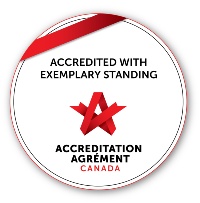Reduce exposure to radon
EN | FR
What is radon?
Radon is a naturally occurring radioactive gas that is released into the air during the breakdown of uranium in soil and rock. Radon is invisible, tasteless, and has no smell. There is no known safe level of radon exposure but reducing levels in our home below the national guideline of 200 Becquerels per cubic metre (Bq/m3) decreases your risk of lung cancer.
Which cancers can be prevented?
As radon breaks down, it forms radioactive particles that are breathed in, then releases energy that can damage your lungs and lead to lung cancer.
Exposure to high levels of radon can increase your risk for lung cancer. The risk of cancer depends on the amount of radon a person is exposed to and how long a person is exposed. According to Health Canada, radon is the leading cause of lung cancer in people who do not smoke, and it increases the risk of lung cancer for people who do smoke. Radon exposure is linked to approximately 16% of lung cancer deaths in Canada.
As an example, we could prevent around 180 cancer cases in 2038 if all Manitobans reduced high levels of radon in their homes, starting today.
How can you test for radon in your home?
Radon can be found in new buildings and old buildings. It can enter a building through cracks in the foundation floors and walls, through gaps around pipes, floor drains, windows, sumps, or through cavities inside the walls.i Radon levels are usually highest in the basement or lowest levels of the building. Levels are usually higher in the winter months because windows stay closed and a vacuum effect pulls more radon into homes.
About 24% of Manitobans may be living in homes with radon levels higher than the national guideline. The only way to know if your home has high levels of radon is to test for it. Homes should be tested for at least three straight months, preferably during the winter. Radon should be tested in the lowest floor of your home where you spend more than four hours a day. This could be the basement or the main floor of your home. Here are two options for testing your home for radon:
- Purchase a test kit that is approved by the Canadian National Radon Proficiency Program (C-NRPP) and follow the instructions provided. There are home-improvement retailers and nonprofit organizations, such as the Manitoba Lung Association that sell easy-to-use long-term radon test kits.
- Hire a certified radon measurement professional. You can find one by contacting the Canadian National Radon Proficiency Program (C-NRPP).
How can you reduce the levels of radon in your home?
Radon can never be eliminated, but radon levels can usually be reduced to levels below the national guideline. If you find high levels of radon in your home, mitigation [the process to reduce radon levels] should be considered to reduce the levels of radon. In Manitoba, radon mitigation through a C-NRPP certified radon mitigation professional qualifies for a loan through the Manitoba Hydro Energy Finance plan. A certified radon mitigation professional can help determine the best and most economical way to lower radon levels in your home. Some options include:
- closing any cracks or holes in the floors and walls
- sealing around pipes and drains
- increasing under-floor ventilation to allow air exchange
- installing specifically designed traps in floor drains to prevent radon from entering the basement
- ventilating the basement sub-floors by installing a pump to pull radon outside
It is important to re-test your home after mitigation to confirm that radon levels have been lowered. You can find more information on programs and resources below to reduce your exposure to radon.
Programs and Services
Canadian National Radon Proficiency Program: Find a Mitigation Professional
Canadian Shield Radon for consultations: Services
Manitoba Hydro: Energy Finance Plan for Radon Mitigation
The Manitoba Lung Association: Purchase Test Kit – Home Radon Test
Purchase your easy-to-use kit: Manitoba - Take Action on Radon
Health Canada: Take Action on Radon
Health Canada: Radon Reduction Guide for Canadians
Canadian – National Radon Proficiency Program (C-NRPP): Information for Homeowners
Canadian Association of Radon Scientists and Technologists: Steps to reduce radon
CAREX: Canada’s resources on exposure to radon gas
Canadian Cancer Society: Radon

